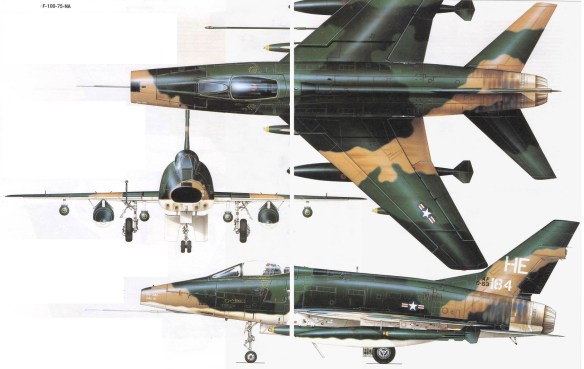
The Super Sabre was the first Air Force fighter to cruise at supersonic speeds. Though designed as an interceptor, it gained renown as a fighter-bomber during the Vietnam War.
In 1948 North American began planning an advanced version of its successful F-86 Sabre jet. It proposed a larger aircraft, with wings sharply swept at 45 degrees and a more powerful engine. It was anticipated such a craft could operate at sustained speeds above the sound barrier. The Air Force authorized a prototype, which emerged in 1953 as a sleek machine with lowset wings, a distinct oval air intake, and a slab tailplane. On its first flight the YF-100 broke the world speed record, easily reaching 750 miles per hour. This made it the world’s fastest fighter with the possible exception of the MiG-19, then under development. In 1954 the new craft entered into production as the F100A Super Sabre; it gained a reputation as a “hot” plane to fly, especially upon landing. Many were lost due to pilots’ unfamiliarity with supersonic flight, but most liked it and nicknamed it the “Hun,” short for “Hundred.”
The F-100Ds, last single-seater version of the first American supersonic fighter, provided with an autopilot and also armed with bombs attached to the underside of the wings, played an important role in the Vietnam war, with over 300,000 missions from August 1964 to July 1971, when the 35th Tactical Fighter Wing finally left Phan Rang to return to the United States. The 615th TFS was the first unit furnished with F-100Ds to reach Da Nang on August 5, 1964, followed on August 17 by the 401st TFW, stationed at Tan Son Nhut. The Super Sabres, familiarly known as ‘Huns’, a shortened version of ‘Hundred’, were immediately used for low-level night bombing missions, and during the first years of the war pounded objectives in South Vietnam where suspected concentrations of Viet Cong had been sighted. For this type of mission the F- 100Ds were armed with two CBU-24 bombs which, on opening, released a large number of anti-personnel devices, and two 750lb (340kg) napalm bombs. Once they had dropped their load, the Super Sabres proceeded to spray the zone under attack with their four 20mm cannons to complete the ‘cleaning up’ work. Because of their adaptability and, even more, the lack of a real alternative, numerous F-100 Wings were used in Vietnam, some of them consisting of squadrons of the Air National Guard, called up for front line service. The 3rd TFW alone carried out more than 100,000 missions in 1969! From the end of 1965 a number of two-seater F-100Fs, the Wild Weasel 1, carrying anti-SAM electronic equipment, were in action, operating from the Korat base in Thailand. After the war, most were turned over to Air National Guard units, where they lingered in service until 1979. F100s also equipped the Air Force’s famed Thunderbirds aerobatic team for 13 years. The Air Force eventually acquired 2,394 Super Sabres, many of which were transferred to the Greek and Turkish air forces. Several are still employed as aerial target drones.